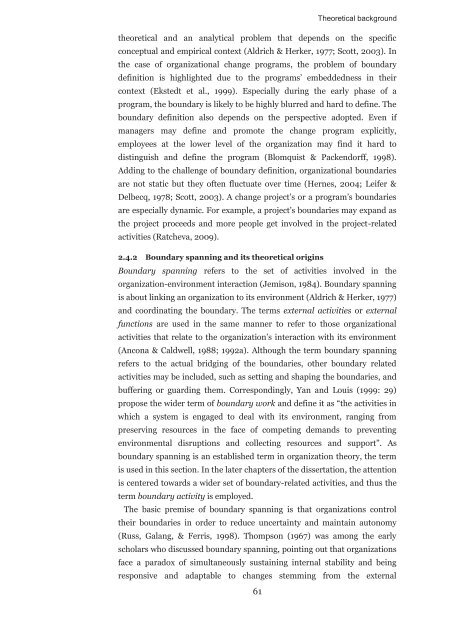Boundary activities and readiness for ... - Projekti-Instituutti
Boundary activities and readiness for ... - Projekti-Instituutti
Boundary activities and readiness for ... - Projekti-Instituutti
You also want an ePaper? Increase the reach of your titles
YUMPU automatically turns print PDFs into web optimized ePapers that Google loves.
Theoretical background<br />
theoretical <strong>and</strong> an analytical problem that depends on the specific<br />
conceptual <strong>and</strong> empirical context (Aldrich & Herker, 1977; Scott, 2003). In<br />
the case of organizational change programs, the problem of boundary<br />
definition is highlighted due to the programs’ embeddedness in their<br />
context (Ekstedt et al., 1999). Especially during the early phase of a<br />
program, the boundary is likely to be highly blurred <strong>and</strong> hard to define. The<br />
boundary definition also depends on the perspective adopted. Even if<br />
managers may define <strong>and</strong> promote the change program explicitly,<br />
employees at the lower level of the organization may find it hard to<br />
distinguish <strong>and</strong> define the program (Blomquist & Packendorff, 1998).<br />
Adding to the challenge of boundary definition, organizational boundaries<br />
are not static but they often fluctuate over time (Hernes, 2004; Leifer &<br />
Delbecq, 1978; Scott, 2003). A change project’s or a program’s boundaries<br />
are especially dynamic. For example, a project’s boundaries may exp<strong>and</strong> as<br />
the project proceeds <strong>and</strong> more people get involved in the project-related<br />
<strong>activities</strong> (Ratcheva, 2009).<br />
2.4.2 <strong>Boundary</strong> spanning <strong>and</strong> its theoretical origins<br />
<strong>Boundary</strong> spanning refers to the set of <strong>activities</strong> involved in the<br />
organization-environment interaction (Jemison, 1984). <strong>Boundary</strong> spanning<br />
is about linking an organization to its environment (Aldrich & Herker, 1977)<br />
<strong>and</strong> coordinating the boundary. The terms external <strong>activities</strong> or external<br />
functions are used in the same manner to refer to those organizational<br />
<strong>activities</strong> that relate to the organization’s interaction with its environment<br />
(Ancona & Caldwell, 1988; 1992a). Although the term boundary spanning<br />
refers to the actual bridging of the boundaries, other boundary related<br />
<strong>activities</strong> may be included, such as setting <strong>and</strong> shaping the boundaries, <strong>and</strong><br />
buffering or guarding them. Correspondingly, Yan <strong>and</strong> Louis (1999: 29)<br />
propose the wider term of boundary work <strong>and</strong> define it as “the <strong>activities</strong> in<br />
which a system is engaged to deal with its environment, ranging from<br />
preserving resources in the face of competing dem<strong>and</strong>s to preventing<br />
environmental disruptions <strong>and</strong> collecting resources <strong>and</strong> support”. As<br />
boundary spanning is an established term in organization theory, the term<br />
is used in this section. In the later chapters of the dissertation, the attention<br />
is centered towards a wider set of boundary-related <strong>activities</strong>, <strong>and</strong> thus the<br />
term boundary activity is employed.<br />
The basic premise of boundary spanning is that organizations control<br />
their boundaries in order to reduce uncertainty <strong>and</strong> maintain autonomy<br />
(Russ, Galang, & Ferris, 1998). Thompson (1967) was among the early<br />
scholars who discussed boundary spanning, pointing out that organizations<br />
face a paradox of simultaneously sustaining internal stability <strong>and</strong> being<br />
responsive <strong>and</strong> adaptable to changes stemming from the external<br />
61









